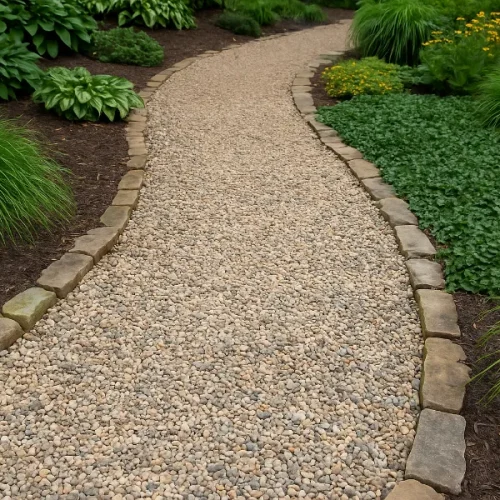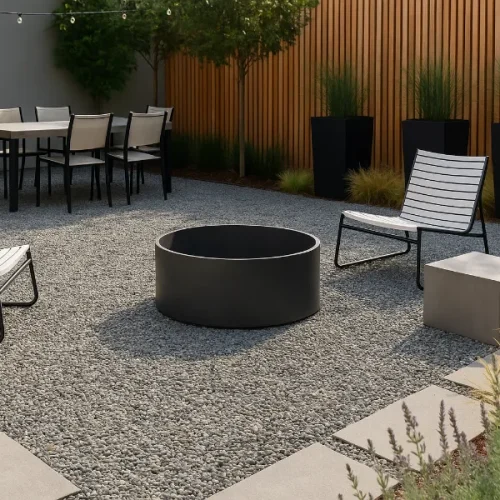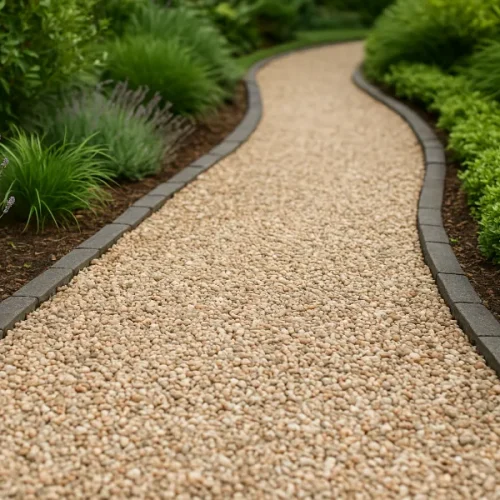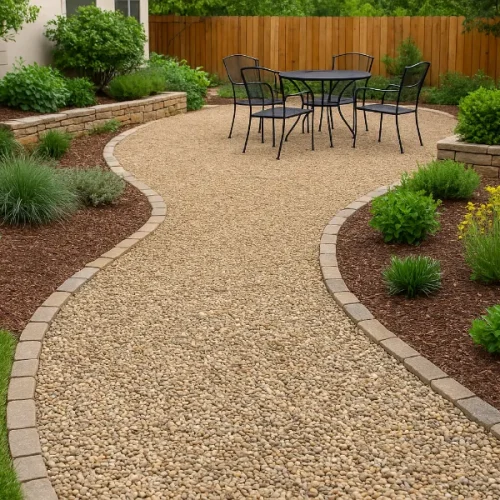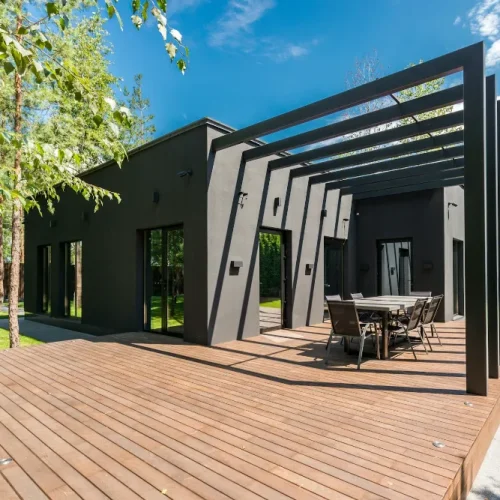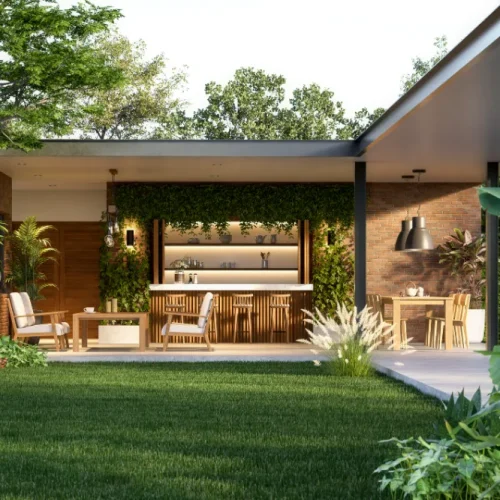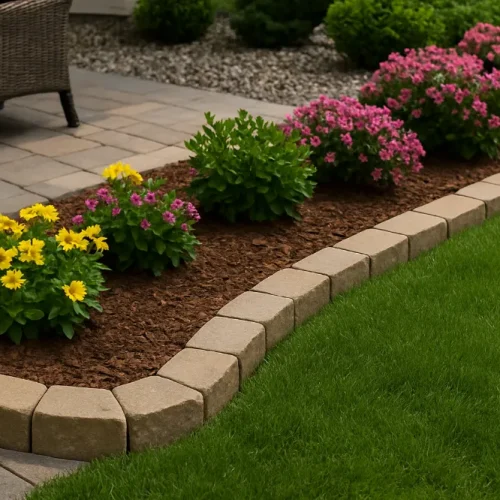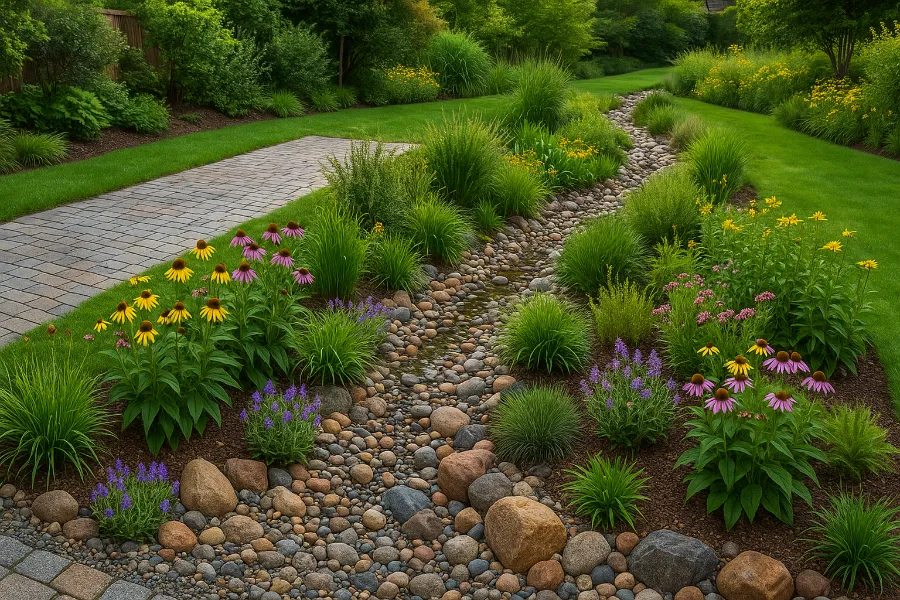
Good landscapes do not happen by accident. They are shaped by sunlight, soil, water, plants, and the invisible systems that help everything stay in balance. One of the most important forces to manage in any landscape is water. When water flows where it should not, it erodes soil, drowns plant roots, puddles on walkways, breeds mosquitoes, and damages buildings. Traditional drainage methods have often relied on simply directing water off a property as quickly as possible. But as more communities experience heavy rainfall and unpredictable weather patterns, rushing stormwater away creates downstream problems such as flooding, soil loss, and water pollution.
Sustainable landscape drainage practices work differently. Instead of treating water as a nuisance, these methods see water as a valuable resource. The goal is to guide, slow, absorb, clean, and reuse water whenever possible. The result is a landscape that looks healthier, functions better, and supports local ecosystems.
Understanding the Problem: Why Sustainable Drainage Matters
Stormwater is rain or melted snow that flows off roofs, driveways, lawns, and streets. In nature, most rainfall soaks slowly into soil where it replenishes groundwater and supports plant life. But in cities and suburbs, large areas of land are covered with concrete, asphalt, and compacted soil that cannot absorb water. The more surfaces that shed water, the faster runoff accumulates. This runoff picks up pollutants such as fertilizers, oil, pesticides, and debris before draining into streams and lakes.
When water moves too fast, it overwhelms drainage systems, causes erosion in yards and riverbanks, and carries pollutants into waterways. Sustainable drainage practices work to restore some of the natural water cycle by increasing infiltration, slowing flow, improving soil structure, and filtering contaminants.
Principles of Sustainable Drainage
Sustainable drainage design does not rely on one product or technique. Instead, it follows a few guiding principles:
- Keep water where it falls whenever possible.
- Reduce hard surfaces that shed water.
- Encourage soil to absorb and hold water.
- Filter runoff to reduce pollution.
- Use plants to stabilize soil and support ecological health.
Thinking about drainage in this way changes how landscapes are built. Instead of just digging trenches or adding pipes, the goal becomes improving the land’s ability to handle water naturally.
Improving Soil Health for Better Drainage
Soil is the foundation of every sustainable drainage strategy. Healthy soil has pores and spaces where water can move underground. But many yards have compacted soil from construction, heavy foot traffic, or mowing machinery. When soil is compacted, water pools on the surface instead of sinking in. Two of the most effective ways to encourage better infiltration are soil aeration and organic matter improvement.
Core aeration involves removing small plugs of soil from the ground to create space for air and water. This helps loosen the soil structure and encourages deeper root growth. Adding compost improves soil texture by increasing organic matter. Organic matter acts like a sponge, helping sandy soils hold water longer and helping clay soils drain more freely. Over time, compost supports beneficial microorganisms that create stable soil structure and help filter pollutants naturally.

Reducing Impervious Surfaces
Driveways, patios, and walkways are often major contributors to runoff. Replacing traditional concrete with permeable alternatives allows water to seep into the ground instead of flowing across the surface. Some options include: Permeable pavers: Individual bricks or stones set with gaps gaps filled by gravel or sand that allow water to pass through.
Permeable concrete or asphalt: Engineered with air pockets so water can seep through. Gravel driveways or walkways: A simple and often more affordable solution. Even small changes help. For example, replacing just one concrete walkway with stepping stones surrounded by groundcover plants can meaningfully increase the amount of water that infiltrates the soil.
Rain Gardens
A rain garden is one of the most popular sustainable drainage features. It is a shallow, landscaped depression that collects runoff from roofs, driveways, or lawns. The depression slows the water and allows it to soak into the soil. Plants in the rain garden help filter pollutants and stabilize the soil.
A well-designed rain garden should not stay wet all the time. Instead, it should hold water briefly after a storm and drain within a day or two. The plants used are typically species that can tolerate periods of both wet and dry conditions.
Bioswales and Vegetated Swales
A bioswale is similar to a rain garden, but it is shaped like a long, shallow channel designed to guide water across a landscape while filtering it. Instead of water running quickly over bare soil or pavement, a bioswale slows the flow and encourages infiltration.
Rainwater Harvesting
Rainwater harvesting systems collect water from roofs and store it for later use such as watering plants, cleaning outdoor surfaces, or flushing toilets. Storing water onsite reduces the amount of runoff leaving a property and reduces demand on municipal water supplies during dry periods.
Green Roofs
Green roofs are vegetated surfaces installed on rooftops. They are particularly effective in dense urban environments where there is very little natural ground to absorb rainwater. Plants help absorb rainfall, reduce roof temperatures, and provide habitat for wildlife.
French Drains and Subsurface Drainage
Some landscapes require underground drainage solutions, especially where soil infiltration is low or slope directs water toward a building. A French drain is a gravel-filled trench with a perforated pipe that redirects underground water. When combined with soil improvement and surface drainage techniques, French drains form part of a balanced system.
Dry Creeks and Rock Swales
A dry creek bed is a decorative channel lined with rocks or boulders that mimics a natural stream. It guides water during storms and adds visual interest when dry. Rocks slow the water and reduce erosion.
Choosing Plants for Better Water Management
Plants are central to sustainable drainage. Their roots hold soil, absorb water, and improve soil pathways for infiltration. Native plants are especially beneficial because they are adapted to local climate conditions and support local ecosystems.
Maintenance and Long-Term Care
Sustainable drainage systems need periodic care. Rain gardens need occasional weeding and re-mulching. Bioswales may require sediment removal. Permeable pavers should be swept to prevent clogging. Compost should be added regularly to maintain soil health. These tasks are light but essential.
Community and Environmental Benefits
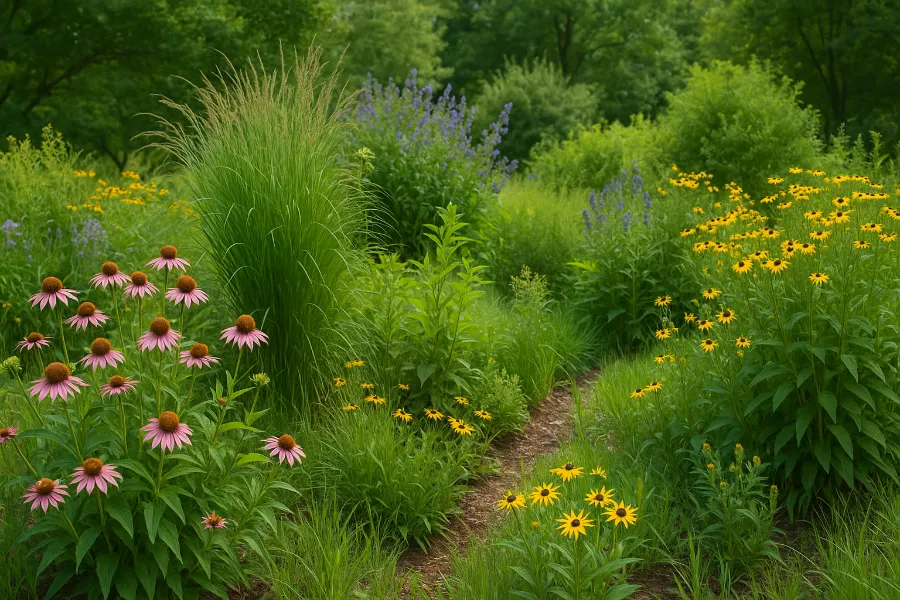
When neighborhoods adopt sustainable drainage practices collectively, flooding decreases, groundwater increases, and waterways become cleaner. Sustainable drainage strengthens communities against climate-driven weather extremes and supports natural ecological processes.
A Future Where Water Stays in Balance
Sustainable landscape drainage reimagines how we relate to water. Instead of pushing water away, we slow it down, guide it gently, and give it space to soak into the ground. Landscapes become healthier, wildlife returns, and maintenance becomes easier. At its core, sustainable drainage is about working with nature rather than against it.
FAQs
Sustainable landscape drainage refers to methods that manage water naturally by increasing infiltration, reducing runoff, and improving soil and plant health.
If stormwater isn’t managed properly, it can cause flooding, erosion, pollution, and damage to property and local waterways.
Rain gardens capture runoff and allow it to soak into the soil while plants help filter pollutants and support biodiversity.
Permeable surfaces allow water to pass through them into the ground instead of running off, reducing erosion and flooding.
Yes. Methods like rainwater harvesting and improved soil infiltration can reduce reliance on municipal water for irrigation.
Yes, but typically low maintenance such as removing sediment, replanting when needed, and checking for clogs in permeable surfaces.
Yes. Native plants are adapted to local conditions and often have deep root systems that improve soil structure and water absorption.
Absolutely. Even small interventions, like a mini rain garden or a rain barrel, can meaningfully improve drainage.
A bioswale is a shallow, vegetated channel designed to direct and slow water flow while filtering pollutants from runoff.





